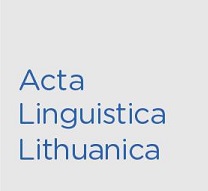Word-formation Patterns of the German and Lithuanian Nomina Loci from the Dictionary of Seven Languages (Sieben-Sprachen-Wörterbuch)
Word-formation Patterns of the German and Lithuanian Nomina Loci from the Dictionary of Seven Languages (Sieben-Sprachen-Wörterbuch)
Author(s): Dalius Jarmalavičius, Danguolė Straižytė, Virginija Jūratė PukevičiūtėSubject(s): Applied Linguistics, Morphology, Lexis, Baltic Languages
Published by: Lietuvių Kalbos Institutas
Keywords: Nomina Loci (place nouns); word-formation; affixes ; compounds; dictionary of seven languages;
Summary/Abstract: This article analyses place nouns (Nomina Loci) in German and their derivational equivalents in Lithuanian. The objective of the paper is to ascertain the similarities and differences between place nouns in German and Lithuanian. The research material was collected from a seven-language multilingual dictionary published in 1918, which was commissioned and compiled by the authorities of the 'Oberost' military administrative unit. On the basis of the selected data (in total, 253 German samples out of 8,OOO word tokens), the aim is to analyse the word-formation tendencies of Nomina Loci in both languages by comparing the German place nouns recorded in the dictionary at the beginning of the 2Oth century with their Lithuanian equivalents. The Nomina Loci study is presented in the following order: first, the place nouns of the German language are analyzed, with the aim of finding out what proportion of the Nomina Loci consists of compounds, derivatives, and simple words (simplicia). In the next stage of the analysis, the words recorded in the source are compared with the equivalents in the Lithuanian part of the dictionary. This part of the article aims at determining the word-formation patterns of Nomina Loci in Lithuanian and comparing them with the German compounds, derivatives, and simple words. The study revealed that out of 253 recorded examples of Nomina Loci found in the German section of the dictionary the majority is comprised of compound and simple words, however, the number of German Nomina Loci made up with affixes is considerably lower. Mostly, German compound place nouns are represented by syntagmas in Lithuanian. German simple place nouns are translated into Lithuanian by using simplicia and less frequently by derivatives, while the Nomina Loci formed with affixes are mostly rendered into Lithuanian by employing derivatives or syntagmas.
Journal: Acta Linguistica Lithuanica
- Issue Year: 2023
- Issue No: 88
- Page Range: 28-46
- Page Count: 19
- Language: English

